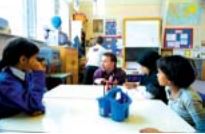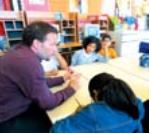
Young children, before they start school, are inclined to ask lots of questions. As adults we are fascinated, amused and sometimes driven mad by this boundless curiosity. Children’s questions are often very philosophical and probing. They take us beyond what we have come to take for granted and are often concerned with the connection between ideas and language. ‘Why is it called a skyscraper?’ says the small boy to the adult sat next to him on a train, ‘is it because it scrapes the sky?’
The range of questions children are asked in schools can often seem narrow, limited to testing their recall of key facts. What sort of activities and situations, then, seem to prompt higher-order questions – the sort of questions that encourage students to be creative and bold and to think ‘outside the box’?
Sorting questions
A challenging change to classroom routine and an excellent activity to encourage higher-order thinking is to invite students to categorise the questions they raised after, for example, reading a story or thinking about what they would like to know at the start of a new project. A practical tip is to use post-its or strips of paper so that children can move their questions around. Ask them to work on sortingquestions into groups and identifying the criterion for each group. Questions can belong to more than one group. You could use Venn diagrams to represent the different categories. Depending on their experience, children come up with all sorts of groupings:
● Ones which have the question marks missing
● Ones about science
● Ones which nobody could know the answer to
● Ones which David thinks he can answer
● Hard ones
Invite the students to sort questions into groups according to whether they can be answered or not. You can end up with different groups such as questions:
● we can answer here and now
● we can find answers to in a book or on the Internet
● we can answer by thinking about them
● we can ask people about
● nobody knows the answers to
● we can never know the answers to
(From: Victor Quinn. Critical Thinking and Young Minds. David Fulton, 1997.)
Using a conceptline
A useful activity here is the use of a conceptline (Murris 2002). On one end of the line (drawn on the board or represented with a rope on the floor) write ‘answer’ and at the other end ‘no answer’. Go through the list of questions and invite the students to place each question somewhere on the line and to give reasons why. In pairs they can reflect together on ‘the correct’ answer to each question. It will soon emerge which questions are more empirical than others.
Year 3 students asked a wide range of questions after reading Maurice Sendak’s Where The Wild Things Are. In the story Max (wearing a play wolfsuit) is sent to bed without his supper after chasing the dog with a fork and calling his Mum ‘Wild Thing’. His bedroom then gradually turns into a forest. A private boat tumbles by that takes him to an island where the Wild Things live. He tames them by staring into their eyes and they make him king of all Wild Things. After a ‘Wild Rumpus’, he feels lonely and smells food, so he decides to give up being king and to return home where his supper is waiting for him. The children’s questions were as follows:
1. Why is Max lonely?
2. Was Max thinking?
3. Why did the animals change him into a king?
4. How did Max’s room turn into a forest?
5. How did Max’s bed turn into a boat?
6. Why did they like Max?
7. Why did the tiger take Max’s boat?
8. How did the river appear?
9. Why was Max on the boat at night?
10. Why did Max go back to his family?
11. Why was Max making mischief?
12. Why did Max get dressed up as a Wild Thing?
13. Why did the forest change back to Max’s room?
14. How did Max go from his world to the other world?
15. What happened to the Wild Things? Why didn’t the sea disappear?
16. Why did Max stay in his room for his supper?
Here we find a good example of the variety of questions such a story can generate. Some can be answered by knowing more about the story (question 15), some contain mistakes (in 7, there is no tiger in the story and the tiger doesn’t take the boat). Other questions can only be answered by thinking carefully about them (questions 1–6). Question 8 needs probing: Does the questioner want an explanation of what happened to the river (the mechanics as it were) or is there a conceptual interest in the nature of dreaming lurking behind the question?
We get more ideas and also better ideas when we use one another’s thoughts like building blocks. The list of questions above represent the children’s first attempt at doing this activity (though they were used to circle time). It surprised us how many questions they came up with. Sometimes it is necessary to focus on asking questions before using stories. You can set a ‘questions homework’, by asking children to: ‘bring in a question tomorrow’. Collect the questions in a question box or hang them on a question wall. It helps if each child ‘owns’ a question. This makes questioning seem more important. You can write the children’s names with their questions (their names were not recorded above, but they were on the flipchart in class). We have noticed that this motivates them to value questions and questioning.

Higher-order questioning
If we want to encourage more open-ended and higher-order questioning, we have to make time and space for learning that is well structured and carefully prepared but also where the direction and the goals are not tightly controlled by us. It is then that students might ask ‘real’ questions, the questions that genuinely puzzle them. We need those questions in order to make education meaningful. Questions are the ‘hooks’ we use to ‘fish’ for new knowledge. Pupils must have opportunities not only to ask questions but admit mistakes, set off in wrong directions and figure out better ones. It is then that we create a classroom of researchers, where problems become creative opportunities for investigations.
It helps if we model intellectual curiosity ourselves and are curious about our students’ personal knowledge and powers of creative thinking. It helps if we listen to students’ own questions and become co-enquirers in the process of constructing answers. We have to learn how to respond in such a way that we can enter into a sustained enquiry without rushing to find the answers we want. We also have to be prepared for the uncertainty and worry that sometimes arises when we give students greater control over the content of enquiries.
Students’ personal experiences may steer their questions into topics such as loss and death. In such cases it is important to be aware of our own anxieties without depriving students of rich opportunities to help each other make sense of the awesome nature of human existence. When a reception child asked ‘What if heaven is full?’ some very logical thinking had been going on. After all, if physical bodies take up space, then why shouldn’t bodies in heaven take up space? But also, was she expressing her fear that when her time has come, there might not be any space left? How important for the that her teacher listened to this profound question and explored possible meanings with her!
Communities of enquiry
In earlier articles for Teaching Thinking, we have described the process and organisation of a community of enquiry, in which children’s questions flourish. (Hayness 2003) This approach to teaching stimulates children’s questions by:
- Offering a wide range of rich and complex material to instigate enquire (stories, images, news items, poems, problems, objects, dilemmas)
- Making it clear that all ideas are valued and will be heard
Inviting children to think about what they find puzzling, interesting, curious, surprising or troubling - Making children’s questions the agenda for discussion
Focussing on questions that involve judgment, so the teacher is not the ultimate authority - Introducing a process through which such questions can be explored and the search for meaning deepened
- Removing barriers of reading and writing that sometimes prevent children from fully taking part in thinking activity
This is consistent with the newly published guidance: Speaking, Listening and Learning (DfES, 2003)
Supporting dialogue through questions
When we hear questions, how do we know which are really worthwhile pursuing? And how do we know what kind of enquiries they demand. In a community of enquiry we can start by asking children to elaborate on their thinking by sorting questions into different categories and by searching for connections between questions.
Sometimes we need to take a back seat as far as answering questions is concerned and to concentrate on ways of helping children to search for meaning and develop their ideas.
A useful strategy is to ask more open procedural questions. Open questions are not information-seeking (asking the person you think knows the answer) or rhetorical (you know the answer yourself ). Open procedural questions invite enquiry.
The following open procedural questions extend children’s thinking and help to address the thinking skills specified in the revised National Curriculum. If teachers ask them, children will soon start asking them too. These questions are not content specific but they can help add rigour to discussions. It helps to make a special effort to focus on one group of questions each week to add variety to you own questioning.
Information-processing questions (listening and clarifying): Could you explain what you mean? Can someone give an example? I’m not sure I understand, are you saying…? Can you tell us a little bit more about your thinking there?
Reasoning questions (expanding and probing): What are your reasons for saying that? Do we have any evidence? Why do you think that is the case? How do you know? How could we answer that?
Enquiry questions (connecting, generalising, making distinctions): So you agree/disagree with…? What is the best question to ask? So you agree with/disagree with…? Can you give an example/counter-example? If you say that, does it follow that…? Is that always the case or only sometimes? What are the exceptions? Is that the same as…? Are you saying exactly what you were saying before? Does your idea connect with…?
Creative thinking questions (speculating, exploring implications and larger context): What if…? Does xxx imply yyy? Is it possible that…? Is that relevant to what we are saying here? Does this change our perspective? Can we think of other reasons to support this view? Suppose that …
Evaluation questions (evaluating, reviewing, concluding, summarising): Has anyone changed their mind? Have we reached any conclusions? What made us think of…? Can anyone summarise what we have said so far? Do we all understand the differences of opinion on this? Has anyone changed their mind in this discussion? Have you learned anything new?
Open substantive questions
Sometimes open questions do have a particular content. They focus on certain abstract concepts. These concepts are often central to our thinking and our actions, so it is no luxury to often understand them better. Examples of concepts that arise frequently in dialogues with children are friendship, life, fairness, integrity, honesty, death, space, time, and ‘animal’. We all use them and they are important, but what do they mean exactly? What is the difference between animals and human beings? Through enquiry we find out that we often aren’t sure of the meanings of the concepts we use. Thinking with others helps us to understand them. This can only be done with the help of other concepts. For example, the concept ‘holiday’ (did Max in Where The Wild Things Are go on holiday?) was explored with the children using ‘work’ and ‘money’ as defining ideas. During this process we puzzled together, searching for criteria. Can you be on holiday when you are playing on the playstation at home?

In the year 3 class mentioned above, eight year old James Galvin called Where The Wild Things Are ‘a spiritual journey’ (as opposed to ‘Max just thinking or dreaming about the Wild Things’). When asked the open substantive question ‘Why call it spiritual, rather than thinking’? he wrote down: ‘I think Max had a spiritual journey because a bed cannot turn into a boat in the physical world and you cannot control your dreams. So Max moved from one world to another leading to question 14.’
When pushing him for further reasons he wrote: ‘A spritual journey is a journey in which you do not move physically … because your spirit is the only part of you that moves.’
When continuing to push him, his writing wasn’t fast enough for the speed of his thoughts, so one of us wrote down for him: ‘’The spirit is the only part that survives death. It’s the only thing that forms a person, what they look like and who they are and also tells you what you are going to do, because it is part of you. It’s the thing that sets out what you’re going to do, because the brain can’t do that. The brain can’t do that, because it only tells your body to move, but not what you are going to do. I don’t believe in science to the end.” (Published with James’s permission).
Ideas for a ‘good questions’ staff meeting
Bring into the meeting a list of questions children have asked, for example, after reading a story. It makes it easier to have them displayed on a flipchart. You can explore those questions and related issues together by asking the following questions:
● What are the questions about? How can we be sure?
● Which are worth pursuing and why?
● What type of questions are these? (a good activity here is to categorise them in small group)
● What makes a question ‘higher order’ and what makes one a good question for enquiry?
● What strategies are we using that are effective in encouraging higher-order questions?
● What kinds of questions from us help to take children’s enquiries forward?
Karen Murris and Joanna Haynes
DialogueWorks is running special one-day questioning courses in 2004 and 2005 around the country (www.dialogueworks.co.uk). For these and other courses please contact Karin@dialogueworks.co.uk
For correspondence contact joanna@appletreecottage.plus.com or
karin@dialogueworks.co.uk Or visit our website:
Reference
Murris, A (2002) Concepts in Question, Teaching Thinking, December 2002, Issue 9
Haynes, J (2003) Philosophically Speaking, Teaching Thinking, 2003, Issue 12
Register for free
No Credit Card required
- Register for free
- Free TeachingTimes Report every month